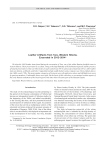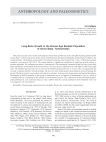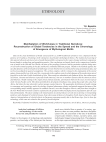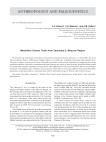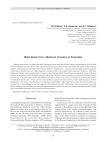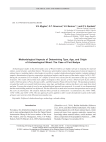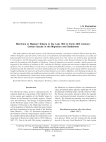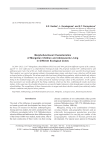Статьи журнала - Archaeology, Ethnology & Anthropology of Eurasia
Все статьи: 351
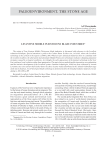
Levantine Middle Pleistocene blade industries
Статья научная
The origin of Near Eastern Middle Pleistocene blade industries is discussed with reference to the Levallois reduction-technique. Special attention is paid to the Gesher Benot Ya'akov site, in Israel, where the Levallois technology is the earliest in the region (ca 800 ka BP). Whereas later Acheulean industries show no continuity with the Levallois tradition, the alternation of predominant Middle Pleistocene technologies indicates changing adaptation strategies caused by ecological conditions. Accordingly, the early appearance of the laminar technology in the Near East evidences local evolution rather than immigration. The major factors underlying this innovation were adaptation and the intrin sic development of the Levallois system. Laminar technologies, which are fi rst evidenced by certain Levantine sites even earlier than Gesher Benot Ya'akov, became widely distributed at the Acheulo-Yabrudian stage of the late Acheulean. A well-developed blade technology is demonstrated by the Amudian industry of Qesem, Israel, dating to 400–200 ka BP.
Бесплатно
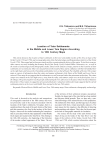
Location of Tatar settlements in the Middle and Lower Tara region according to 18th century maps
Статья
Тhis article discusses the location of Tatar settlements in the lower and middle reaches of the Tara on maps of the Tarsky Uyezd (1784 and 1798) and on topographic plan of the Kartashevskago and Bergamotskaya districts of the Tarsky Uyezd (1798). These maps had not been previously used for reconstructing the history of the region. To test their accuracy, other sources are used, including the Inventory Book of the Tarsky Uyezd, Gerhard Miller’s itineraries, etc., as well as the results of archaeological and ethnographic studies. Based on the analysis of maps, patterns in the locations of Tatar settlements are reconstructed. They were situated between the mouth of Tara and its confl uence with the Chertalinka River on the right bank, and between the Chertalinka and Kalinka rivers on the left bank. The reliability of the late 18th century maps as sources of information about the winter and summer settlements of the Tatars of the Middle and Lower Tara is assessed. These maps do not suggest that the settlements were still seasonal rather than permanent at that time. The winter camps were situated on the Tara high terrace, away from the valley, and summer camps were on the fl ood plain, close to the villages. The general pattern was that people settled along the river, often close to the places where the Tara tributaries fl owed into it. Place names are suggestive of seasonal settlements. Comparison with modern maps suggests that the current settlements pattern on the Lower and Middle Tara emerged in the late 18th century.
Бесплатно
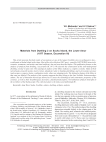
Materials from dwelling 2 on Suchu island, the Lower Amur (1977 season, excavation III)
Статья
This article presents the fi nal results of excavations at one of the largest Neolithic sites in northeastern Asia— a settlement on Suchu Island on the Amur. Most of the rich collection (3967 spec.), owned by IAET SB RAS (stone tools, ceramics, ornaments, and artistic and ritual artifacts), has not been described before. This publication focuses on the analysis of artifacts from dwelling 2 (excavation III, 1977). We describe the construction of this semi-underground dwelling, circular in plan view. The typological analysis of the lithics indicates a complex economy. Many of them (arrowheads, projectile points, inserts, knives, plummets) relate to hunting and fi shing, and to processing carcasses (end-scrapers, scrapers, burins, combination tools), others are chopping tools. The distinctive feature of the lithics is that some are bifacial. The analysis of the ceramics suggests that they belong to the Late Neolithic Voznesenovskoye culture. The use of binocular microscopy allowed us to assess the technological and constructive properties of the ceramics, as well as their morphological, decorative, and functional features. Non-ut ilitarian artifacts shed light on the worldview of the Suchu people. The collection dates to the mid-second millennium BC.
Бесплатно
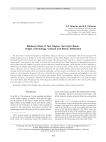
Medieval sites of Tara region, the Irtysh basin: origin, chronology, cultural and ethnic attribution
Статья
Бесплатно
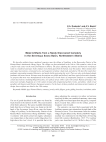
Metal artifacts from a newly discovered cemetery in the Severnaya Sosva basin, Northwestern Siberia
Статья обзорная
Бесплатно
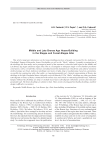
Middle and Late Bronze Age house-building in the steppe and forest-steppe Altai
Статья обзорная
Бесплатно
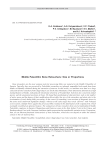
Middle paleolithic bone retouchers: size or proportions
Статья
Bone retouchers are the most common tools for processing lithic raw material in the Middle Paleolithic of Eurasia. Typically, they are perceived by Paleolithic researchers as informal, unmodifi ed tools made from bone blanks accidentally obtained during the extraction of marrow. In this article, we introduce new data on a large collection of bone retouchers from Chagyrskaya Cave (in the Altai Mountains). Their dimensions demonstrate a high standardization of blanks, indicating the intentional selectivity of Neanderthals. Selection also concerned animal species and the anatomical positions of bones. We found that morphological characteristics such as the number of active areas and the degree of their modifi cation did not affect the size of the retouchers and attest only to the reorientation of tools during lithic processing. In the course of retouching, cross-sections of diagnostic traces in the active areas underwent signifi cant changes: whereas at the early stages they reveal “furrows” with V-shaped cross-sections, multiple blows against the processed lithic resulted in the deformation of the original form, which eventually resembled an upturned trapeze. The comparison of bone retouchers from several multicultural Middle Paleolithic complexes in Eurasia (Chagyrskaya and Denisova caves in the Altai, Kabazi V site in the Crimea, and Barakayevskaya Cave in the Caucasus) evidences similar proportions but considerable variation in size. Proportions, then, are an inherent functional characteristic of bone retouchers, which does not depend on either the cultural context or the raw material base.
Бесплатно
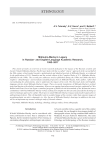
Miklouho-Maclay's legacy in Russian and English-language academic research, 1992-2017
Статья обзорная
Бесплатно
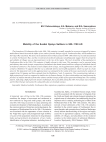
Mobility of the Suzdal Opolye settlers in 900-1150 AD
Статья
The formation of Northeastern Rus in the 10th–11th centuries is usually regarded as a process triggered by intense multicultural interaction and the infl ux of new settlers from the Dnieper region, Northwestern Rus, and Scandinavia to the Volga-Oka watershed. The dense rural settlement network that existed in 1000–1300, which was recently documented in central Northeastern Rus, and the reconstructed medieval landscapes unambiguously suggest that the prosperity and stability of villages was an important factor in the rise of the region. The level of mobility of the population in Northeastern Rus in the 10th–12th centuries is highly relevant to this issue. This parameter can be assessed using paleodietary data on the isotopic composition of strontium in the dental enamel and bone collagen of individuals buried at medieval cemeteries. The analysis of such samples from a large, rural agglomeration dating to the 10th–early 13th centuries, Shekshovo-9, suggests that this was a culturally diverse and wealthy population, which was part of a trade network. The migration level in this agglomeration was estimated by the results of the mass spectrometric analysis of samples from 24 humans and three animals from the Shekshovo-2 and -9 cemeteries. The reconstructions indicate a high proportion of locals as compared to similar sites in Eastern Europe. No direct relationship was found between the presence of artifacts introduced from other cultures and the isotopic profi le of fi rst-generation immigrants. The resulting pattern, indicating a high proportion of native individuals, has no parallels among the 10th–11th century sites in Eastern and Northern Europe represented by comparable data on strontium isotopes.
Бесплатно
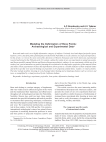
Modeling the deformation of bone points: archaeological and experimental data
Статья обзорная
Бесплатно
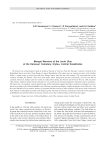
Mongol warriors of the Jochi ulus at the Karasuyr cemetery, Ulytau, Central Kazakhstan
Статья обзорная
Бесплатно

